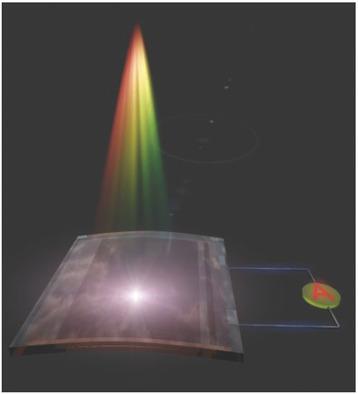当前位置:
X-MOL 学术
›
Adv. Opt. Mater.
›
论文详情
Our official English website, www.x-mol.net, welcomes your
feedback! (Note: you will need to create a separate account there.)
Development of Organic Semiconductor Photodetectors: From Mechanism to Applications
Advanced Optical Materials ( IF 8.0 ) Pub Date : 2018-09-02 , DOI: 10.1002/adom.201800522 Dezhi Yang 1 , Dongge Ma 1
Advanced Optical Materials ( IF 8.0 ) Pub Date : 2018-09-02 , DOI: 10.1002/adom.201800522 Dezhi Yang 1 , Dongge Ma 1
Affiliation

|
Photodetectors that convert a light signal into an electrical signal have wide applications in light signal detection. As an emerging candidate for next‐generation light sensing, organic photodetectors compensate well for the shortages of the traditional inorganic photodetectors in terms of ease of processing, compatibility with flexible substrates, tunable absorption characteristics, low‐cost manufacturing, and being lightweight. Currently, regular improvements in organic photodetectors are made with respect to their important figure‐of‐merit performances, which have caught up to or even surpassed the performances of inorganic Si and Ge‐based photodetectors. Importantly, the spectral response of organic photodetectors covers a wide range of wavelengths, from the ultraviolet to near‐infrared regions, with low‐band‐gap organic semiconductors as the active medium. In this paper, the working mechanism and recent advances in organic semiconductor photodetectors are comprehensively reviewed and the challenges in the field, mainly focusing on the performance of organic photodetectors, studies oriented toward applications, and the expectations of organic semiconductor photodetectors in the future, are disclosed.
中文翻译:

有机半导体光电探测器的发展:从机理到应用
将光信号转换成电信号的光电检测器在光信号检测中具有广泛的应用。作为下一代光感测的新兴候选者,有机光电探测器在处理容易性,与柔性基板的兼容性,可调吸收特性,低成本制造以及轻巧性等方面可以很好地弥补传统无机光电探测器的不足。目前,有机光电探测器的重要性能指标已得到定期改进,已赶上甚至超过了无机硅和锗基光电探测器的性能。重要的是,有机光电探测器的光谱响应涵盖了从紫外线到近红外区域的各种波长,以低带隙有机半导体作为活性介质。本文对有机半导体光电探测器的工作机理和最新进展进行了全面综述,并重点研究了有机半导体光电探测器的性能,面向应用的研究以及对有机半导体光电探测器未来的展望。披露。
更新日期:2018-09-02
中文翻译:

有机半导体光电探测器的发展:从机理到应用
将光信号转换成电信号的光电检测器在光信号检测中具有广泛的应用。作为下一代光感测的新兴候选者,有机光电探测器在处理容易性,与柔性基板的兼容性,可调吸收特性,低成本制造以及轻巧性等方面可以很好地弥补传统无机光电探测器的不足。目前,有机光电探测器的重要性能指标已得到定期改进,已赶上甚至超过了无机硅和锗基光电探测器的性能。重要的是,有机光电探测器的光谱响应涵盖了从紫外线到近红外区域的各种波长,以低带隙有机半导体作为活性介质。本文对有机半导体光电探测器的工作机理和最新进展进行了全面综述,并重点研究了有机半导体光电探测器的性能,面向应用的研究以及对有机半导体光电探测器未来的展望。披露。











































 京公网安备 11010802027423号
京公网安备 11010802027423号